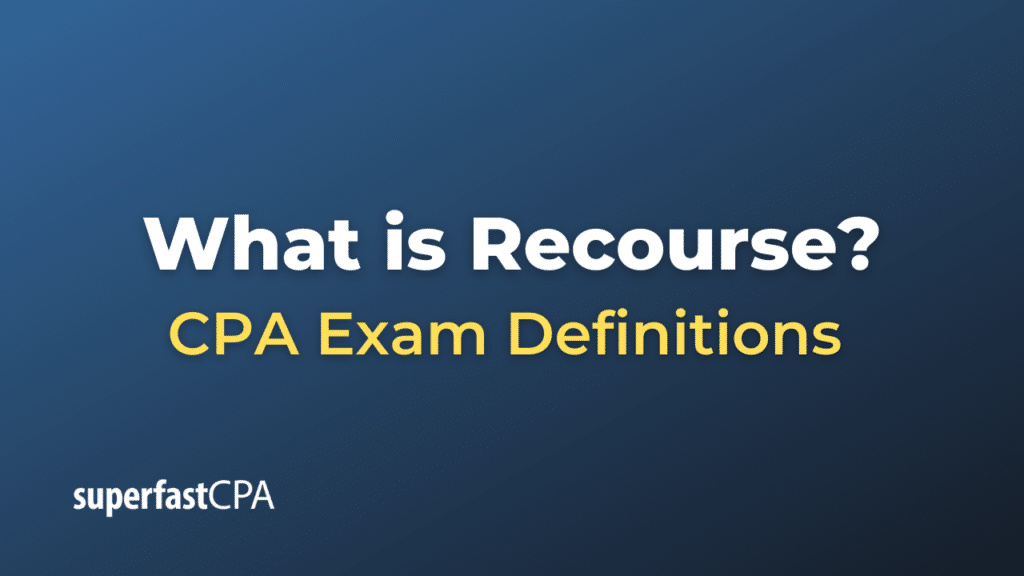Recourse
In financial and legal contexts, “recourse” refers to the legal right to collect a debt or obligation from a defaulting party. It provides the lender or party with an entitlement to seek payment or further action in the event that the primary obligor fails to fulfill their obligations.
Recourse is commonly encountered in lending agreements:
Example: Recourse in a Loan Agreement
Suppose Jane takes out a loan from Bank XYZ, and the loan agreement states that it is a “recourse loan.” Jane uses the loan to purchase a car. If Jane defaults on the loan (i.e., she stops making payments), the bank has the following rights under the recourse agreement:
- Repossess the Collateral: Bank XYZ can take the car (which is the collateral for the loan) and sell it to recover the amount owed.
- Pursue Additional Compensation : If the sale of the car doesn’t cover the full amount Jane owes, Bank XYZ can pursue Jane for the remaining balance. This means that the bank can legally go after Jane’s other assets or income to make up for the deficit.
Recourse vs. Non-Recourse Loans:
- Recourse Loan : As described above, a recourse loan allows the lender to go after the borrower’s other assets or income if the collateral doesn’t cover the loan amount in case of default.
- Non-Recourse Loan: A non-recourse loan limits the lender’s recovery to the collateral itself. If the borrower defaults and the sale of the collateral doesn’t cover the loan amount, the lender has to absorb the loss and cannot pursue the borrower’s other assets.
In essence, recourse provides an added layer of protection for the lender. However, it also means increased risk for the borrower, who could potentially lose more than just the collateral if they default on a recourse loan. Before entering into any financial agreement, it’s essential to understand whether the terms are recourse or non-recourse and to be aware of the associated implications.
Example of Recourse
Let’s delve deeper into recourse with a real-world example involving real estate.
Example: Recourse in a Mortgage Loan
Background: John secures a $500,000 mortgage from LenderBank to buy a house. The mortgage agreement specifies that it is a recourse loan.
Scenario 1 – Default and Sufficient Collateral Sale:
- Two years later, due to unforeseen financial difficulties, John defaults on his mortgage. At that time, he still owes LenderBank $450,000.
- LenderBank proceeds to foreclose on the property.
- The house is sold at foreclosure for $460,000.
- After covering the outstanding balance of $450,000, the remaining $10,000 is returned to John, minus any fees and costs associated with the foreclosure process.
In this scenario, the sale of the collateral (the house) covered John’s debt, and no further action from LenderBank is required.
Scenario 2 – Default and Insufficient Collateral Sale:
- The real estate market has taken a downturn. Two years after John took out his mortgage, he defaults, with $450,000 still outstanding.
- LenderBank forecloses on the property.
- Due to the market downturn, the house only sells for $420,000 at foreclosure.
- After the sale, there’s still a $30,000 deficit between what John owed and what LenderBank recovered from selling the property.
- Since it’s a recourse loan, LenderBank can pursue John for the remaining $30,000. They might do this by garnishing his wages, freezing his bank accounts, or placing liens on his other assets until the debt is satisfied.
In contrast, if John’s mortgage had been a non-recourse loan, LenderBank would have to absorb the $30,000 loss and would not be able to pursue John’s other assets.
This example highlights the additional risks borrowers face with recourse loans. They might lose not only the collateral (in this case, the house) but also be responsible for further payments if the collateral doesn’t fully cover the outstanding debt. On the other hand, the lender is better protected in a recourse agreement since they have more avenues to recover their funds in the event of a default.













